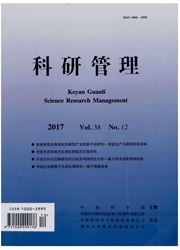

 中文摘要:
中文摘要:
根据"坚持以人为本,全面、协调、可持续发展"的科学发展观,通过指标的海选和筛选构建了适合于中国省级行政区的科技综合评价指标体系。根据科技投入与产出、科技对经济和社会的影响等评价准则,利用聚类分析方法把14个省级行政区分成好、中、差三类,建立了基于超效率DEA的科学技术评价模型,对中国14个典型的省级行政区进行了实证研究并提出了政策性建议。本文的特色与创新一是通过聚类把科技实力接近的省级行政区分成一类,分别对每一类的省级行政区用DEA方法评价,避免了把不同类型的评价对象进行评价导致评价结果失真的弊端。二是通过对输入冗余和输出不足的计算,揭示没有达到效率最优的省级行政区的科技投入过剩和科技产出不足。根据这些科技投入过剩和科技产出不足提出了有针对性的政策建议。三是通过科技对经济的影响准则来兼顾协调与可持续发展原则,建立了反映科学发展观内涵的协调与可持续发展的指标体系。
 英文摘要:
英文摘要:
According to the scientific developmentview putting people first and aiming at the comprehensive,coordinattive and sustainable development,the comprehensive evaluation system of science and technology is established through widely choosing and filtrating targets,which is fit for 14 province districts. On the basis of the evaluating rules,such as science and technology input/output,impact of science and technology on the economy and society and so on,14 province districts are classified as three categories-good,medium,and bad by the clustering method and the empirical research conducted on them puts the feasible advice forward using the established science and technology evaluation model based on the super-efficiency DEA. Its features and innovations are as follows:Firstly,it puts together the provinces whose science and technology strengths are close by the clustering method and the DEA is used to evaluate each category so that the phenomenon of anamorphic evaluation results for different kinds of evaluating objects will not happen. Secondly,it reveals the input redundancy and the output deficiency of science and technology for the province districts which don't reach the optimal efficiency by calculating the input redundancy and the output deficiency. In the light of these results,the feasible advice is provided. Thirdly,according to the impact principle of science and technology on economy,the coordinative and sustainable development are taken into account and a target system of coordinative and sustainable development reflecting the connotation of scinetific development view is set up.
 同期刊论文项目
同期刊论文项目
 同项目期刊论文
同项目期刊论文
 期刊信息
期刊信息
